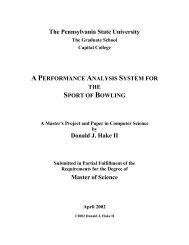k-Nearest Neighbor Classification on Spatial Data Streams Using P ...
k-Nearest Neighbor Classification on Spatial Data Streams Using P ...
k-Nearest Neighbor Classification on Spatial Data Streams Using P ...
Create successful ePaper yourself
Turn your PDF publications into a flip-book with our unique Google optimized e-Paper software.
3.2 Computing the <str<strong>on</strong>g>Nearest</str<strong>on</strong>g> <str<strong>on</strong>g>Neighbor</str<strong>on</strong>g>s<br />
For HOBS: P i,j is the basic P-tree for bit j of band i and P′ i,j is the complement of P i,j .<br />
Let, b i,j = j th bit of the i th band of the target pixel, and define<br />
Pt i,j = P i,j , if b i,j = 1,<br />
= P′ i,j , otherwise.<br />
We can say that the root count of Pt i,j is the number of pixels in the training dataset<br />
having as same value as the j th bit of the i th band of the target pixel. Let,<br />
Pv i,1-j = Pt i,1 & Pt i,2 & Pt i,3 & … & Pt i,j , and<br />
Pd(j) = Pv 1,1-j & Pv 2,1- j & Pv 3,1- j & … & Pv n-1,1- j<br />
where & is the P-tree AND operator and n is the number of bands. Pv i,1-j counts the<br />
pixels having as same bit values as the target pixel in the higher order j bits of i th<br />
band. We calculate the initial neighborhood P-tree, Pnn = Pd(8), the exact matching,<br />
c<strong>on</strong>sidering 8-bit values. Then we calculate Pnn = Pd(7), matching in 7 higher order<br />
bits; then Then Pnn = Pd(6) and so <strong>on</strong>. We c<strong>on</strong>tinue as l<strong>on</strong>g as root count of Pnn is<br />
less than k. Pnn represents closed-KNN set and the root count of Pnn is the number of<br />
the nearest pixels. A 1 bit in Pnn for a pixel means that pixel is in closed-KNN set.<br />
The algorithm for finding nearest neighbors is given in Fig. 4.<br />
Input: P i,j for all bit i and band j, the basic P-trees<br />
and b i,j for all i and j, the bits for the target pixels<br />
Output: Pnn, the P-tree representing closed-KNN<br />
// n - # of bands, m - # of bits in each band<br />
FOR i = 1 TO n-1 D<br />
FOR j = 1 TO m DO<br />
IF b i,j = 1 Pt ij P i,j<br />
ELSE Pt i,j P′ i,j<br />
FOR i = 1 TO n-1 DO<br />
Pv i,1 Pt i,1<br />
FOR j = 2 TO m DO<br />
Pv i,j Pv i,j-1 & Pt i,j<br />
s m<br />
REPEAT<br />
Pnn Pv 1,s<br />
FOR r = 2 TO n-1 DO<br />
Pnn Pnn & Pv r,s<br />
s s - 1<br />
UNTIL RootCount(Pnn) ≥ k<br />
Fig. 4. Algorithm to find closed-KNN set based <strong>on</strong> HOB metric<br />
For Perfect Centering: Let v i is the value of the target pixels for band i. The value P-<br />
tree, P i (v i ), represents the pixels having value v i in band i. The algorithm for<br />
computing the value P-trees is given in Fig. 5(b). For finding the initial nearest<br />
neighbors (the exact matches), we calculate<br />
Pnn = P 1 (v 1 ) & P 2 (v 2 ) & P 3 (v 3 ) & … & P n-1 (v n-1 )<br />
that represents the pixels having the same values in each band as that of the target<br />
pixel. If the root count of Pnn ≤ k, we expand neighborhood al<strong>on</strong>g each dimensi<strong>on</strong>.<br />
For each band i, we calculate range P-tree Pr i = P i (v i -1) | P i (v i ) | P i (v i +1). ‘|’ is the P-<br />
tree OR operator. Pr i represents the pixels having any value in the range [v i -1, v i +1] of<br />
band i. The ANDed result of these range P-trees, Pr i , for all i, produce the expanded<br />
neighborhood. The algorithm is given in Fig. 5(a).
















